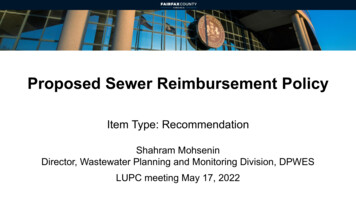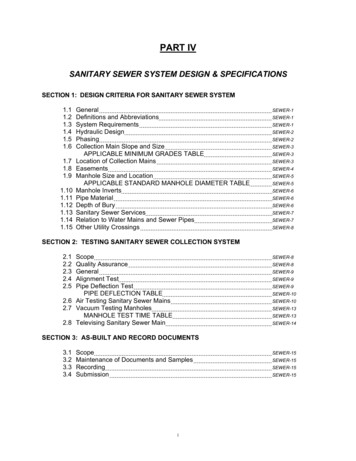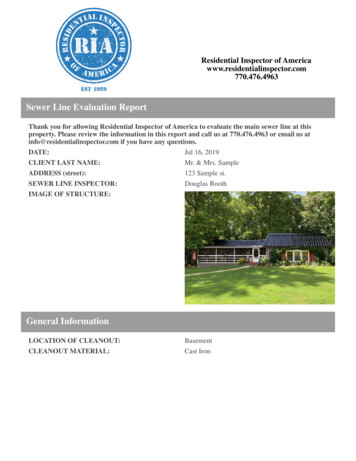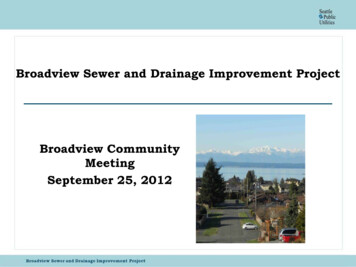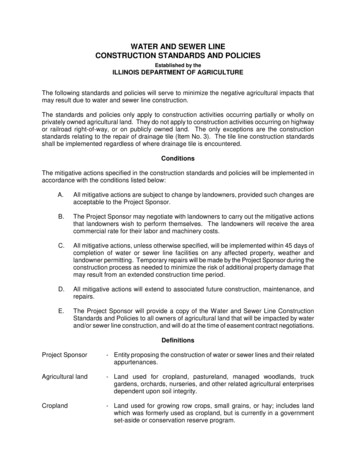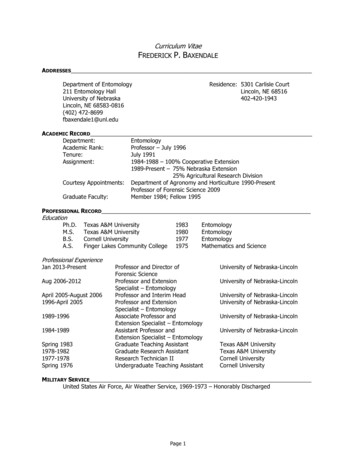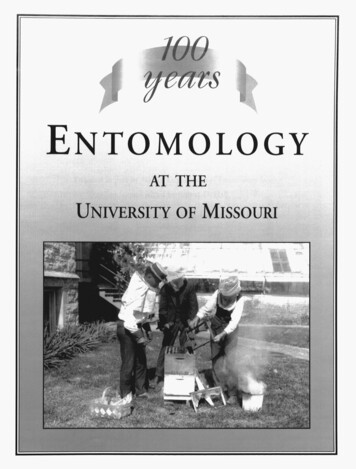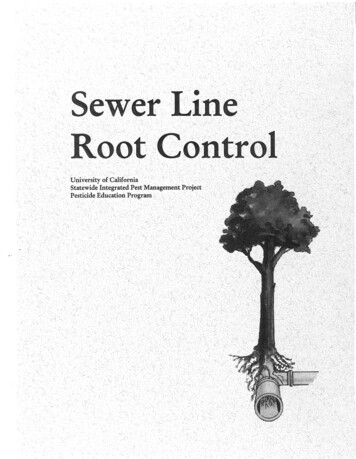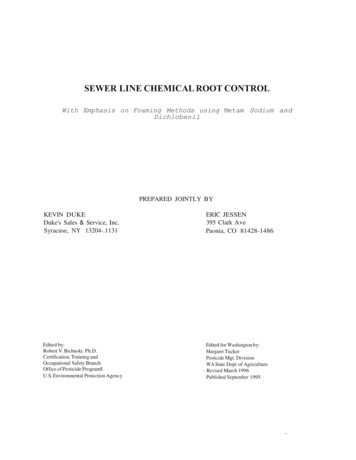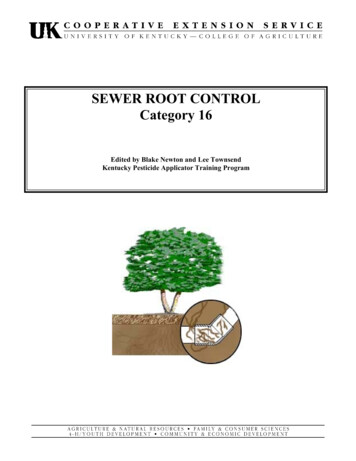
Transcription
SEWER ROOT CONTROLCategory 16Edited by Blake Newton and Lee TownsendKentucky Pesticide Applicator Training Program
SEWER LINE ROOT CONTROLPREFACEThis publication was prepared by specialists in the University of Kentucky CooperativeExtension Service. Material was adapted from the US EPA manual “Sewer LineChemical Root Control with Emphasis on Foaming Methods Using Metam-Sodium”,originally developed under the direction of R. V. Bielarski and authored by E. Jessen andK. Duke. When used in conjunction with the EPA core manual, “Applying PesticidesCorrectly,” this manual will provide information to meet minimum EPA standards forcertification of commercial applicators in Category #, Sewer Line Root Control.Additional helpful information for Sewer Line Root Control applicators may be obtainedfrom regulatory agencies, pesticide labeling, pesticide dealers, and pesticide industryrepresentatives.INTRODUCTION: ROOT RELATED SEWER PROBLEMS. . . . . . . . . . . . . . . . . . . . . 4ROOT GROWTH. . . . . . . . . . . . . . . . . . . . . . . . . . . . . . . . . . . . . . . . . . . . . . . . . . . . . . . . 3IDENTIFYING ROOT PROBLEMS IN SEWER LINES. . . . . . . . . . . . . . . . . . . . . . . . . 5ROOT CONTROL METHODS. . . . . . . . . . . . . . . . . . . . . . . . . . . . . . . . . . . . . . . . . . . . . 5NON-CHEMICAL ROOT CONTROL METHODS. . . . . . . . . . . . . . . . . . . . . . . . . . . . . 6CHEMICAL ROOT CONTROLS. . . . . . . . . . . . . . . . . . . . . . . . . . . . . . . . . . . . . . . . . . . 7METAM-SODIUM AND DICHLOBENIL. . . . . . . . . . . . . . . . . . . . . . . . . . . . . . . . . . . . 8APPLICATION OF METAM-SODIUM FOR ROOT CONTROL. . . . . . . . . . . . . . . . . 11APPLICATION CONCERNS. . . . . . . . . . . . . . . . . . . . . . . . . . . . . . . . . . . . . . . . . . . . . . 22APPLICATION CHECKLIST. . . . . . . . . . . . . . . . . . . . . . . . . . . . . . . . . . . . . . . . . . . . . 29DETERMINING EFFECTIVENESS OF ROOT CONTROL TREATMENTS. . . . . . . . 29ENVIRONMENTAL CONCERNS. . . . . . . . . . . . . . . . . . . . . . . . . . . . . . . . . . . . . . . . . 30GLOSSARY. . . . . . . . . . . . . . . . . . . . . . . . . . . . . . . . . . . . . . . . . . . . . . . . . . . . . . . . . . . 31
INTRODUCTION: ROOT RELATED SEWER PROBLEMSThe intrusion of roots into waste collection pipes is probably the most destructiveproblem encountered in a sewer system. These roots can block or reduce flow, causeoverflows, or reduce hydraulic capacity (leading to a loss of self-scouring velocities).Sewer pipes with blocked or reduced flow often have septic pools that produce hydrogensulfide and other dangerous or odor causing gases. Roots also can damage pipes andother structural parts of the waste collection system. Because sewer systems areunderground and out of sight, sewer stoppages and overflows are the way that mostmunicipalities and homeowners find out about root problems. Structural damage, oftenmore costly than stoppages, usually goes unnoticed until the damage is determinedthrough television probing.To be successful, any pest control program must be effective and must not cause harm tothe public, the environment, or to the sewer system itself. The use of products containingmetam-sodium is one of the most common methods of sewer line root control. Metamsodium has been classified as a “Restricted Use” pesticide because of concerns thatimproper use of its formulations could adversely affect the health of humans, animals,and the environment. Sewer line root control is a matter of using the right technologies,safely. The purpose of this training manual is to provide the technical basics of sewerline root control, with an emphasis on the safe use of chemicals that contain metamsodium.ROOT GROWTHRoots anchor and hold plants upright. They store food, and absorb water and nutrients.Roots are tenacious and long-lived. Often, a root system will live after the abovegroundportions of a plant have been destroyed. Willow-tree root systems can survive for yearsafter the top has been removed. The root systems of some grasses are believed to havebeen alive for thousands of years. Roots can also grow incredible distances to find waterand nutrients: live tree roots have been found penetrating pipes in the Rocky Mountainsalmost 2 miles from the nearest tree.Types of Root Systems. Plants may have either a fibrous or a tap root system. Plantswith fibrous root systems, like most garden plants and grasses, occupy upper soil layersand are normally not associated with sewer problems. Trees and woody plants have taproot systems. The primary roots of tap root systems grow down into the soil, oftenreaching the water table. Secondary roots grow laterally from the primary root. Thesebranches can grow to be several inches in diameter. If they invade sewer pipes, they canexert enough pressure to spread a pipe joint and break the pipe. The leading tip of a rootshoot, the root meristem, senses and grows toward minute increases in nutrient andmoisture gradients. This allows a root to locate a sewer pipe, which may be covered withcoated condensation caused by temperature differences, or may be seeping nutrient-rich3
water into surrounding soil from cracks, joints, or even from the porosity of the pipeitself.Factors affecting root growth. The soil conditions around sewer lines can influence rootgrowth. Backfill used during sewer construction may provide more favorable soil thanundisturbed ground. Water table levels fluctuate seasonally. During drier seasons, treeroots will grow deeper in search of moisture. During colder seasons, roots may be drawnto the warmer soil surrounding a sewer pipe. Root growth is generally greatest in fall,winter, and in the spring before the tree leafs out. This is when roots store and distributenutrients. Root growth is less active in the spring and summer when the abovegroundparts of the plant are growing.Root growth into sewer pipes. In urban areas, tree roots may have a hard time findinggood sources of nutrients. Limited green space, the removal of leaves and other organicdebris from lawns, and the draining away of surface water by sewer systems cause rootsto seek water and nutrition at greater depths. Roots thrive in sewer pipes. The sewagesystem is a perfect environment: well-ventilated, oxygen-rich, and full with water andnutrients. Microscopic openings in sewer systems can permit hair-like root structures topenetrate pipe joints, cracks, connections, or any other opening. A secondary root maygrow alongside a sewer pipe for many feet, exploiting each opportunity to penetrate intothe system.The roots of most trees cannot grow or survive if they are constantly submerged so rootsare usually not a problem in sewers that are located below a permanent water table. If thewater table fluctuates, or if porous soil profiles allow rapid downward movement ofrainwater, roots can be found in saturated soil and can be a major cause of sewerinfiltration. In this case, tree roots suspended into the sewer system carry on metabolicactivity while the woody, submerged portion of the root systems serve as a pipeline forplant nutrients.Types of root invasions. The two types of root structures found in sewer lines are knownas veil and tail. A veil root structure occurs in lines with steady, constant flows, such asinterceptor pipes. The roots penetrate the pipe at the top or sides and hang from the uppersurface like a curtain, touching the flow. The roots rake the flow and accumulate solids,debris, grease, and other organic materials. Eventually, the root mass and accumulatedmaterial can cause flow blockage, and gasses may develop.Tail root structures occur in sewers that have very low or intermittent flow, such as insmall diameter collector sewers, building sewers, and storm drains. A tail root invasionlooks like a horse’s tail. The roots will grow into the pipe from the top, bottom, or sides,and continue to grow downstream, filling the pipe. Tail root structures over 20 feet longhave been removed from sewers. Such root structures may appear as solid tubes of treeroot, possibly with a slightly flattened area along the bottom where submergence in sewerflows prevents root growth.4
IDENTIFYING ROOT PROBLEMS IN SEWER LINESPest identification is usually the first and most important step in a pesticide controlprogram but in sewer line root control, pest identification is not an issue. The species oftree producing nuisance roots does not matter. All roots in sewer lines are consideredpests – there are no beneficial species. However, because the sewer system isunderground, the cause of a blockage is not always apparent and may not always be dueto root infiltration. Control with metam-sodium, for instance, is not warranted if thecause of a stoppage is not due to roots.Ways to determine root problems in sewer collection lines:Maintenance histories will indicate sewer lines that have experienced a stoppage and thecause of stoppage.Sewer line television reports provide accurate evidence of a root problem.Root prone areas. Sewer lines in the same area that were installed at the same time withsimilar nearby tree-planting patterns may experience similar root problems.Conditions that increase the likelihood of root problems in a particular sewer section:C Sewers located near other sewers with known root problems.C Pipes located near the surface, closer to tree roots.C Lines located off-road in wooded easements, in tree-lined streets, or at the curb linenear trees and roots. In general, sewer lines in residential areas are more susceptibleto root problems than lines in industrial areas.C Lines with many lateral connections per lineal foot, affording greater opportunity forroot intrusion.C Sewer lines constructed with loose-fitting joints or out-dated joint packing material.Asbestos-cement pipe, orangeburg pipe, and clay tile sewers with oakum joints arevery susceptible to root penetration. Pipe with air-tight gaskets and seamless pipe areless susceptible.A map (scattergram) of the local sewer system with known root problem lines highlightedis a useful tool for planning root control programs. As new problems arise and arehighlighted on the map, patterns emerge which indicate that an area is root prone.ROOT CONTROL METHODSThere are several chemical and non-chemical sewer line root control methods. In somecases, chemical treatments cannot be used, especially when near sewage treatment plantsor because of some other environmental or safety consideration. In these cases,mechanical methods must be used. Some cultural control methods are also importantpreventative root control measures.5
Non-Chemical Root Control MethodsCultural control of roots in sewers are routine management practices that can preventroots from invading lines. Cultural controls must be implemented before roots become aproblem. The two most important cultural control methods are: 1) careful installationand inspection of sewer lines during construction, and 2) control over the selection of treespecies and planting sites near sewer lines. Municipalities should carefully inspectconnections where plumbers join building laterals to main sewer lines. Also,homeowners should be advised of the potential for future root problems and should bediscouraged from planting deep-rooted or fast-growing trees near sewer lines. Willowtrees in particular have quick-growing, long-reaching roots. When a sewer root problemis detected, it is usually too late for cultural control.Physical control. Physical control measures for sewer lines involve isolating the sewerpipe from the roots around or near the sewer pipe. Three examples of physical control aretree removal, pipe replacement, and pipe re-lining.Tree removal works best when the roots of a single troublesome tree have invadedpipes. It is often difficult to convince homeowners to let their trees be removed.Removal is risky because it does not guarantee the death of the roots. For tree removalto be effective, the stump should be pulled or chemically treated with a basalapplication herbicide.Pipe replacement involves removing old, defective sewer lines and laying down newpipes. The new sewers should have airtight joints and properly installed connections inorder to prevent roots from becoming a problem. Pipe replacement, however, is costly,often disrupts traffic, and damages property and trees near the sewer line. Also, rootscan still enter through non-replaceable building sewers. If a pipe is in danger ofcollapsing or starting to fail, replacement may be the best control method.Sewer line can also be rehabilitated by pipe re-lining. One method, “slip-lining,”involves pulling a seamless pipe through the existing sewer and digging only wherebuilding laterals require connecting. Another method, “cured-in-place” lining, involvesinflating and curing a sock or plastic tube that conforms to the shape of the pipe. Then,robotic devices are used to cut building connections into the liner. Pipe re-lining canaddress root infiltration problems and correct some structural defects and is lessdisruptive than pipe replacement. It also can provide long-term control against root regrowth through joints. However, re-lining often is more costly than replacement, androots can still enter though building laterals. Even after re-lining sewer main-lines,chemical control may be required to prevent roots from entering through serviceconnections.Mechanical control is the most important and common method of control. It involves theuse of tools or other devices that cut and remove roots from sewers. Its main advantage is6
that it is the only method for relieving a root blockage. Chemicals are ineffective anddangerous when used in plugged or surcharging sewers. Sewer stoppage is an emergencysituation and the municipality should have some type of mechanical control device forcorrecting such problems. The main disadvantage of mechanical control is that itprovides no residual control or long-term effectiveness. Root masses grow back heaviereach time they are cut. Tap roots continue to grow in diameter and, in time, place stresson sewer pipe. Good results are obtained if the roots are cut flush with the joints,however, offset joints and cut-in laterals can prevent the use of full-gauge cleaning tools.Mechanical control is often used in conjunction with chemical control and physicalcontrol (for example, to prepare sewer lines for pipe re-lining).Drill machines, also called coil rodders, are hand or power-driven flexible steel cablesthat turn augers or blades within the sewer. They are most often used by plumbers torelieve blockages in house-lines or other small diameter sewers, and rarely in main-linesewers.Rodding machines are flexible steel rods with rotating blade cutters, augers, orcorkscrews. Rodding machines are most effective in small diameter sewers, up to 12”.Jetters, also known as flushers, flush trucks, jet rodders, jet trucks, and hydraulic sewercleaners, consist of a high pressure water pump, water tank, hose reel, and ½” to 1”sewer cleaning hose. Water shooting through orifices in the rear of the nozzle propelsthe hose through the sewer, blasting it through obstructions. As the hose and nozzle areretrieved, debris is hydraulically flushed back to the insertion manhole for removal.Jetters can also be equipped with water-propelled spinning root cutters. Root cuttersoften get snagged however, and can only be removed by digging them out.Winches, also called drag machines or bucket machines, are large, engine-drivenwinches that pull buckets, brushes, or porcupine-like scrapers through the sewer.Winches are most often used in large diameter sewers that cannot be cleaned efficientlywith jetters. Winches are useful for heavy cleaning to remove large volumes of solids.Chemical Root ControlsRoot control products, like all chemicals used to kill plants, are herbicides. Herbicideskill plants by contact or systemic action. Contact herbicides, like metam-sodium, have alocalized effect and cause quick dieback only of the parts of the plant that they touch.Systemic herbicides are absorbed by roots or foliage and are carried throughout theplant. They take time, two weeks or more, to provide desired results.Herbicide activity is either selective or non-selective. Selective herbicides kill onlycertain types of plants, and are used to reduce unwanted weeds without harming desirableplants. Some herbicides, for instance, affect only broadleaf plants, while others affectonly grasses. Non-selective herbicides kill all plants contacted if applied at an adequate7
rate. They are used when no plant growth is wanted. Metam-sodium is a non-selectiveherbicide.METAM-SODIUM AND DICHLOBENILMetam-sodium and dichlobenil have been used together to control roots in sewers inKentucky for approximately 30 years. Metam-sodium kills the plant roots, whiledichlobenil is an effective growth inhibitor. They are applied together as a dry foam.Metam-sodiumMetam-sodium (sodium-N-methyldithiocarbamate) is also known as metam, methamsodium, SMDC, and Vapam . Metam-sodium is a fumigant. It breaks down into a gas,methylisothiocyanate (MITC), which kills the plant roots.Formulation. Metam-sodium products are currently available as 18% - 42% aqueoussolutions (AS). At present, metam-sodium products for sewer usage may only be appliedas a foam similar to that of an aerosol shaving cream. The dryer phase of this foam isused to treat smaller pipe (less than 12” – 14” diameter). Wetter foam is used to treatlarger pipe (14” diameter). Specially designed foam generating equipment is required toproduce and deliver the foam to the interior of the pipe.Foam is used to deliver root control chemicals because it:C effectively fills the pipe void above the flow line, contacting the pipe walls and rootmassesC does not break down for a period of time after application, maintaining the requiredcontact timeC prevents metam vapor from drifting through pipes into manholes and house ventsC contains surfactants and emulsifiers which increase the effectiveness of the treatmentby assisting the herbicides in penetrating through the grease and organic deposits onroot massesStatus. Metam-sodium is a Restricted Use pesticide. Products intended for sewer rootcontrol that contain it can only be purchased and/or applied by or under the directsupervision of an applicator certified in this category. Labels of products containingmetam-sodium display the signal word DANGER. This indicates that metam-sodium isa highly toxic pesticide that is very likely to cause acute illness from oral, dermal, orinhalation exposure, or to cause severe eye or skin irritation.Reactivity. Metam-sodium is stable under normal conditions and very stable at a pH of8.8 or greater. Metam-sodium is unstable below pH 7. Under this condition, it breaksdown into other products. Prolonged exposure to air results in gradual decomposition toform MITC, a poisonous gas. When metam-sodium is mixed with water it rapidlyhydrolyzes to MITC. The MITC gas penetrates the root mass to kill the roots. MITC ismuch more toxic than metam-sodium and may reach unsafe levels in poorly ventilated or8
confined spaces. The use of air-supplied respirators is required under suchconditions.During normal conditions, metam-sodium is diluted with water and air is added to form afoam. Dilution causes rapid breakdown of the metam-sodium.Toxicology. Metam sodium is acutely toxic and is considered a possible carcinogen bythe U.S. EPA. Its breakdown product and the actual pesticidal compound, MITC, is apotent mucus membrane irritant. Studies with laboratory animals fed the activveingredient for several days can cause pregnant females to lose weight, arly pregnancyloss, and fetuses and offspring to have skeletal irregularities and brain defects. Metamsodium is a mutagen. In cultures of human cells it has caused increased chromosomalaberrations.Metam sodium is a Category I for skin irritation, Category II for acute dermal toxicity andCategory III/IV for eye irritation. Skin exposure tests demonstrated significant adverseeffects to the immune system of laboratory animals. Metam sodium breaks down intoseveral other toxic chemicals. These include two highly flammable and toxic compounds,monomethylamine and carbon disulfide. Carbon disulfide is listed as a female and malereproductive toxicant, and as a developmental toxicant. It can be inhaled or absorbedthrough the skin, and rapidly enters the bloodstream through the lungs. It interferes withalcohol metabolism, which can result in alcohol poisoning if an exposed person ingestsalcohol. Carbon disulfide causes direct injury to the cells lining the blood vessels andchanges the body's metabolism of fats. Hydrogen sulfide is another highly toxicdecomposition product of metam-sodium.Inhalation exposure. The risk of exposure to metam-sodium itself by inhalation isassumed to be slight. However, metam-sodium decomposes to MITC, CS2, H2S, andother gases. MITC is extremely irritating to respiratory mucous membranes, eyes, andlungs. Inhalation of MITC may cause pulmonary edema (severe respiratory distress,coughing of bloody, frothy sputum). For this reason, metam-sodium must be usedoutdoors only, and precautions must be taken to avoid inhalation of evolved gas bywearing an approved canister respirator or air-supplied respirator. If pulmonary irritationor edema occurs as a result of inhaling MITC, the victim should be transported promptlyto a medical facility.Dermal exposure. Exposure to metam-sodium through the skin is expected to be slight ifadequate personal protection equipment (PPE) is worn. These include chemical resistantgloves, a long-sleeved shirt, goggles and/or any other equipment (as stated on productlabel or labeling). Since the surface of the skin is acidic (pH 4.5 – 6) metam-sodium willdecompose to MITC upon contact. It is extremely irritating to the skin and eyes.Exposed areas should be treated immediately with copious amounts of water to avoidburns and corneal injury. Medical attention should be sought if pain or irritation persists.9
Environmental HazardsSome environmental statements appear on nearly every pesticide label. They arereminders of common sense ways to avoid contaminating the environment. Metamsodium root control labels follow these general statements with specific toxicitystatements and steps to take to avoid harming the environment. For example, the metamsodium label contains:C The statement “toxic to fish and wildlife,” and “equipment washwaters and wastesresulting from the use of this product may be disposed of on-site according to labeldirections for use,” by flushing the wastes into the sewer line just treated, “or at anapproved waste disposal facility.”C Precautions not to use the product “in storm, field, or other drains unless the effluentis treated in a sanitary sewer system.” And, “keep of lawns and plants as they may beseverely injured.”C Instructions on how to clean spill areas: “foam should be shoveled off planted areasimmediately rather than washing of with water.”FlammabilityThe metam-sodium root control label reads, “Do not use or store near heat or openflames.”Other PrecautionsMetam-sodium root control product labels contain two special USE PRECAUTIONsections, “Use precaution around buildings” and “Use precaution aroundwastewater treatment plants.” These concerns are discussed in detail in sections tofollow.DichlobenilDichlobenil is a residual-type pesticide formulated as a 50% or 85% wettable powder forsewer use. Dichlobenil kills weeds by impairing metabolic processes that are unique toplant life. Toxicity to mammals is considered low. However, care should be exercisedwhen handling this and any pesticide, especially when used in combination with otherpesticides such as metam-sodium. Consult the product’s labeling for precautionaryinstructions.10
APPLICATION OF METAM-SODIUM FOR ROOT CONTROLUsing proper application methods and correctly calibrating equipment can assure themost effective use of root control chemicals. Proper use of chemicals and equipmentminimizes the operation costs for the applicator and protects the health and safety of theapplicator, the public, the environment, and the wastewater collection system.Application EquipmentThe design and components of foam generating equipment vary but the basic steps ofoperation are the same:1) The chemicals and wetting/foaming agents are diluted with water according to themanufacturer’s label instructions. One type of equipment uses a trailer mountedmix tank (30 – 300 gallons) in which the chemical ingredients are diluted withwater. The trailer is then used to transport the chemical to various application sites.One 200-gallon tank mix is sufficient to treat approximately 1600 feet of 8” pipe.The chemical/water solution is delivered under pressure (100 – 150 psi) to a foamproduction chamber. A positive displacement pump is then used to pump thechemical/water solutionA second type of equipment utilizes a small 3 – 6 gallon chemical tank in which thechemical ingredients are mixed, but water is not added. This unit has a positivedisplacement roller pump or a hydrojetter unit to deliver water (without chemical)under pressure (100 – 150 psi) to a venturi, at which point the chemical isintroduced into the water stream and mixed ahead of the foam production chamber.The chemical is then diluted with water during the application process. Thechemical/water dilution ratio is based on the concentration of active ingredients inthe product, as indicated on the product label.2) 10 to 15 CFM (80 – 140 psi) of air from a compressor is combined with thewater/chemical solution in the foam production chamber producing the desiredfoam.3) Foam is delivered to the interior of the pipe through hoses varying in size from ¾” –1¼”.Foaming Techniques for Applying Metam-Sodium ProductsHose Insertion MethodThis is the most common and lowest risk method of foam application. A foam deliveryhose is inserted through the section of pipe to be treated. Foam is pumped from a foamgenerator through the hose as it is retracted at a predetermined rate. The foam deliveryhose may require an external mechanism such as a hydrojetter or rodding-machine tomove the hose through the pipe prior to the foaming process. This procedure utilizes atwo-stage nozzle with foam generation equipment adapted to a standard high-pressurehydrojetter. The two-stage nozzle allows the hydrojetter to “jet” through the pipe to be11
treated. When the pressure drops, the large portion of the nozzle opens to allow theunrestricted flow of foam to be pumped through. The insertion manhole may be upstreamor downstream. Whenever possible, however, the upstream manhole is the best forinsertion, as this avoids drift toward the applicator. The pumping equipment is startedonce the hose reaches the other manhole. When foam begins to appear, the dischargehose is retracted at a specific rate. With jetters it is recommended that moderate pressuresbe used when inserting the hose into the pipe. High pressures and excessive cleaning mayresult in excessive root damage, which can hinder the efficiency of the root controlchemicals.Hose Insertion M ethodHose Insertion Method – Split TreatmentsSometimes the sewer stretch may be longer than the amount of discharge hose, or it maynot be possible to get the discharge hose completely through the sewer. In these cases, itmay be necessary to use two set-ups to treat a section. With this technique, treat thedownstream portion first, as this reduces drift toward the applicator.Hose Insertion Method – Pushing a SlugFoam will penetrate a distance beyond the discharge nozzle. If masses of roots or otherobstructions do not permit the hose to be conveyed completely through the sewer, theequipment may be “allowed to pump” at a fixed location until the foam works its waythrough the obstruction. The equipment is then set up at the opposite manhole and theprocedure is repeated until the two “slugs” of foam meet and overlap. EXTREMECAUTION: Foam may travel further than desired up service laterals when this method isused. Foam will always take the path of least resistance, which may be up a cellar floordrain or through outside building clean-outs.Hose Insertion Method – “Pulling the Water Out”In some cases sewer pipe may have inadequate slope, or swales in which water collects.As the foam is injected it displaces the water in the pipe. Under these conditions it isoften advisable to treat using the downstream manhole as the insertion manhole. As thehose is retrieved, excess water is pulled toward the insertion manhole. If the upstream12
manhole is used as the insertion manhole, then water may pond in the upstream manhole.If this happens, equipment must be shut down until water recedes.Hose Insertion Method: Treating Service Lateral Connections from the MainOften it is desirable to treat service connections from the main. This provides animportant side benefit to homeowners. Generally treating service connections from themain is only feasible in small diameter (6” – 10”) pipe. In large diameter pipe it is notpossible to build up the pressures needed to penetrate service connections. Additionalfoam in the amount needed for the given number and size of building laterals is requiredto use this method. EXTREME CAUTION is required to prevent foam from reachingbuilding floor drains or outside sewer cleanouts.Treating Service Lateral Connections from the M ainSurface Coating Large Diameter PipesWhen treating large diameter pipe it is often impossible or too costly to completely fillthe sewer line with foam. Remember, though, that only the chemical that contacts rootsis useful. Excess chemical is wasted and could affect the downstream treatment plant.To coat the pipe surface in large diameter pipes, an elevated nozzle is pulled through thesewer. Foam is ejected through the nozzle above the wastewater flow where it contactsand stick
Sewer line root control is a matter of using the right technologies, safely. The purpose of this training manual is to provide the technical basics of sewer line root control, with an emphasis on the safe use of chemicals that contain metam-sodium. ROOT GROWTH Roots anchor and hold plants upright. They store food, and absorb water and nutrients.
